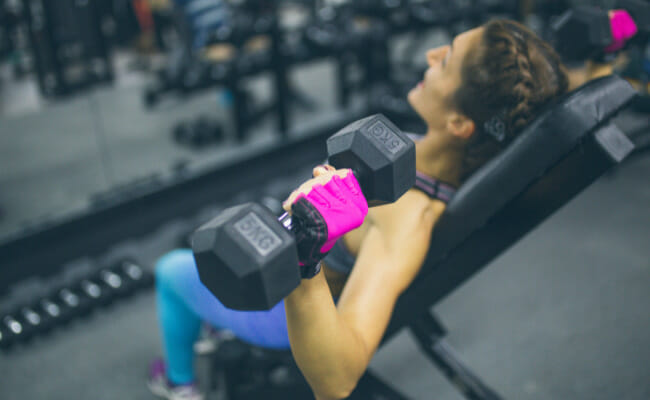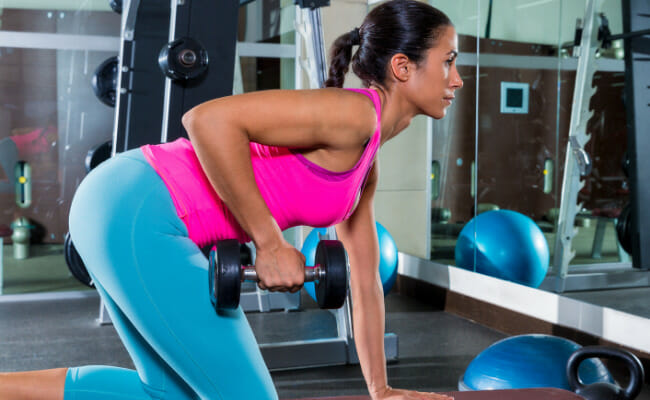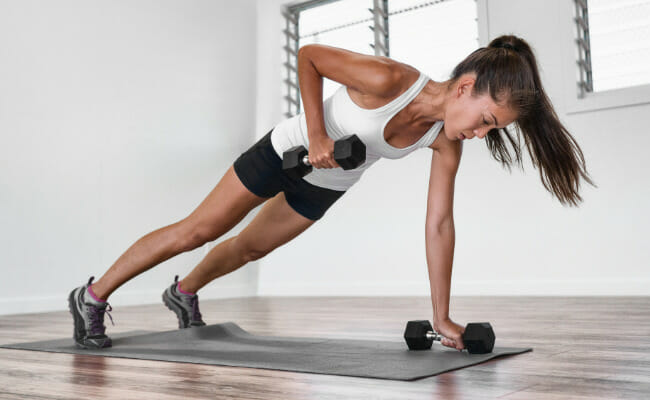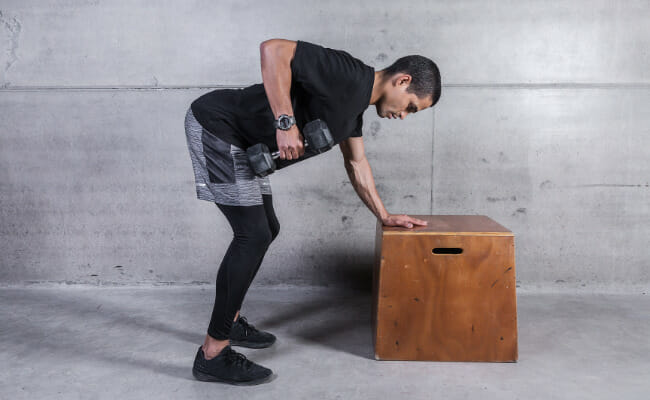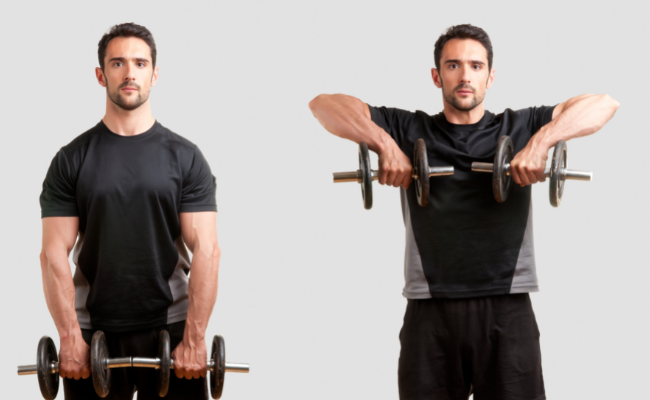Back muscles are essential: they help you maintain good posture, make it possible to do physical activities that involve using your back muscles, and add visual definition to your physique.
Dumbbell exercises are a great option if you’re looking for an effective way to work these muscles. Grab one dumbbell or even a pair of dumbbells – we’ve got a list of the best dumbbell back exercises to help you start building your back.
Anatomy of the Back

Here are the main muscles of the back and how they function.
- Erector Spinae helps with head movements, spine extensions, and lateral flexion.
- Trapezius (Traps) are mainly responsible for outward rotation, elevation, and depression.
- Latissimus Dorsi (Lats) main movements are shoulder extension, shoulder rotation, and horizontal adduction.
- Rhomboids are responsible for scapula adduction, elevation, and inward rotation.
Benefits of Dumbbell Back Workout
Dumbbell back exercises have a couple of benefits for your back workout. They can help strengthen muscle imbalances and are great for stabilizing muscles.
It also feels easier on your shoulder, elbow, and wrist joints since you can lift with a neutral grip. Single arm dumbbell rows will help to correct any body imbalances resulting from other workouts.
Training variables
With dumbbells, you can easily alter your body positioning and grip at any time. More than any other tool, dumbbells allow for a combination of various grips, which have different effects.
Ten best dumbbell back workouts
- Bent-over Dumbbell Row
- Dumbbell Incline Row
- Single Arm Dumbbell Row
- Dumbbell Plank Row
- Dumbbell Renegade Row
- Chest Supported Row
- Dumbbell Seal Row
- Dumbbell Row to Hip
- Dumbbell High Pull
- Dumbbell Upright Row
1. Bent-over Dumbbell Row
The dumbbell bent-over row is very similar to the barbell row. We recommend an overhand grip to emphasize your upper arms, biceps, shoulders, and grip.
How to perform dumbbell bent over row:
- With one dumbbell in each hand, hinge your hips until the dumbbell gets below your knees.
- Drop your shoulders and raise your chest, squeezing your shoulder blades as you row in front of your hips.
- Your elbows should angle away from your torso at around 45 degrees.
- Pause a bit, then slowly lower the weights.
- Reset and repeat.
2. Dumbbell Incline Row
This row variation is very strict and keeps your chest glued to the pad. The incline bench changes your pull angle slightly to help strengthen your lower lats.
How to perform dumbbell incline row:
- Lie on the weight bench with your face down, chest resting on the bench, and legs straight. You can also use inclined benches.
- Use a neutral grip to pull the dumbbells away from the bench while retracting your shoulders.
- Ensure to keep your body on the bench always. Hold the position for a second, and then lower the dumbbells.
- Reset and repeat.
3. Single Arm Dumbbell Row
This classic back workout requires only a single dumbbell. With single-arm dumbbells, you can comfortably and safely work your back while supporting your upper body with one arm.
How to perform single-arm dumbbell row:
- Assume a bent position with your back straight and lower leg placed at the end of the bench.
- Make sure your core is tightened, and then use one arm to pick up a dumbbell towards and past your lats while you contract your back muscles as you inhale.
4. Dumbbell Plank Row
This back workout is excellent for your back, core, and biceps. You only need one dumbbell and a chair or bench to lean on, so it’s ideal for your home exercises.
How to perform dumbbell plank row:
- Your starting position would be to grip a dumbbell with one hand and place the other on the chair/bench.
- Keep your body straight and your feet backward.
- Allow the dumbbell to hang down while you contract your abs and shoulder muscles.
- Pull up the dumbbell towards your ribs without twisting your shoulders and hips.
- Let your elbows lead and position your upper arm beside you. Extend your arm and repeat.
5. Dumbbell Renegade Row
Renegade rows are like a more advanced form of the plank row, supporting muscle growth at your back and core.
The pushup phase emphasizes your chest and triceps, then pressing up and rowing the dumbbell to your hips are great for your abs, lats, and rhomboids.
6. Chest Supported Row
The dumbbell chest-supported row keeps your chest steady on the adjustable bench as you pull, focusing on your upper back muscles.
How to perform chest-supported row:
- With your bench inclined at 45 degrees, grip two dumbbells and position your chest on the bench, leaning into it.
- Allow your arms to hang down as you hold each dumbbell with a neutral grip while securing your feet.
- Retract your shoulders and row the dumbbells outwards, ensuring that you keep your chest against the bench.
- Lower the dumbbells slowly, reset, and repeat.
7. Dumbbell Seal Row
The seal row is a chest-supported row where you lay completely flat without your feet touching the ground.
How to perform dumbbell seal row:
- Set your bench so your hands can extend fully without the dumbbells reaching the ground.
- Lie face down with the dumbbells on both sides and contract your abs.
- Row the dumbbell upwards until you feel it in your upper back.
- Lower the dumbbells to get your arms straight, and repeat.
8. Dumbbell Row to Hip
Rowing towards the outsides of your hips helps to target the lower lats, which can be hard to reach.
How to perform this row to hip:
- Grip the dumbbell with one hand, keep your back leg straight, and then support your other hand and knee on a bench at the starting position.
- Lift the dumbbell to your shoulder and row it low outside your hip.
- Keep your chest up and shoulders down throughout the workout.
- Pause a bit, lower the dumbbell slowly, and then repeat on the other side.
9. Dumbbell High Pull
This back exercise is excellent for your lower back and also your upper traps.
How to perform dumbbell high pull:
- Grip two dumbbells in both hands and hold them in front of your thighs, palms facing your legs.
- Have your knees slightly bent, lower back straight, and lower the weights above your knees.
- As you stand explosively, use the momentum to pull the dumbbells to your chest, keeping your elbows slightly bent above hand level.
- Lower the weights, rest and repeat.
10. Dumbbell Upright Row
Many trainers would tell you to avoid upright rows due to the dangers of a shoulder joint injury. But doing these back exercises with dumbbells is quite different and effective.
Always keep your elbows below your shoulders at all times to keep your shoulders safe.
Conclusion
Whatever your fitness goals are, working on your back muscles is essential. A good back workout can elevate your fitness routine and help you build your body’s strength and balance. The good news is that there are plenty of great dumbbell exercises you can incorporate into your gym sessions and change your life. So what are you waiting for? Try out some of our suggested workouts and see the results for yourself!

